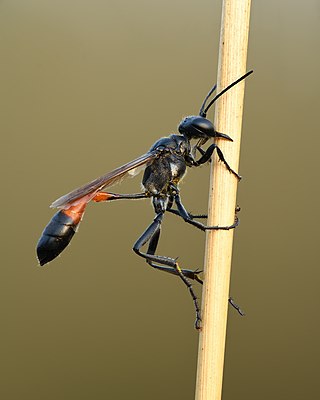
Wasps of the genus Sphex are cosmopolitan predators that sting and paralyze prey insects. Sphex is one of many genera in the old digger wasp family Sphecidae, though most apart from the Sphecinae have now been moved to the family Crabronidae. There are over 130 known Sphex species.

The Sphecidae are a cosmopolitan family of wasps of the suborder Apocrita that includes sand wasps, mud daubers, and other thread-waisted wasps.

Sceliphron, also known as black mud daubers or black mud-dauber wasps, is a genus of Hymenoptera of the Sphecidae family of wasps. They are solitary mud daubers and build nests made of mud. Nests are frequently constructed in shaded niches, often just inside of windows or vent openings, and it may take a female only a day to construct a cell requiring dozens of trips carrying mud. Females will add new cells one by one to the nest after each cell is provisioned. They provision these nests with spiders, such as crab spiders, orb-weaver spiders and jumping spiders in particular, as food for the developing larvae. Each mud cell contains one egg and is provided with several prey items. Females of some species lay a modest average of 15 eggs over their whole lifespan. Various parasites attack these nests, including several species of cuckoo wasps, primarily by sneaking into the nest while the resident mud dauber is out foraging.

Sphex ichneumoneus, known commonly as the great golden digger wasp or great golden sand digger is a wasp in the family Sphecidae. It is identified by the golden pubescence on its head and thorax, its reddish orange legs, and partly reddish orange body. This wasp is native to the Western Hemisphere, from Canada to South America, and provisions its young with various types of paralyzed Orthoptera.

Sphex pensylvanicus, the great black wasp, is a species of digger wasp. It lives across most of North America and grows to a size of 20–35 mm (0.8–1.4 in). The larvae feed on living insects that the females paralyze and carry to the underground nest.

Ammophila sabulosa, the red-banded sand wasp, is a species of the subfamily Ammophilinae of the solitary hunting wasp family Sphecidae, also called digger wasps. Found across Eurasia, the parasitoid wasp is notable for the mass provisioning behaviour of the females, hunting caterpillars mainly on sunny days, paralysing them with a sting, and burying them in a burrow with a single egg. The species is also remarkable for the extent to which females parasitise their own species, either stealing prey from nests of other females to provision their own nests, or in brood parasitism, removing the other female's egg and laying one of her own instead.

Chlorion is a genus of parasitoid wasps in the family Sphecidae. Species have been recorded from the Americas, Africa and tropical Asia through to Java; they appear to prey mostly on Orthopteran insects.

Sphex funerarius, the golden digger wasp, is a species of digger wasp of the family Sphecidae.
Vsevolod Vladimirovich Gussakovskiy was a Soviet entomologist who specialised in Hymenoptera. He described many new species.

Sphex dorsalis is a species of thread-waisted wasp in the family Sphecidae. It is found from the southern United States south to Mexico, Central America, and South America.

Sphex nudus, the katydid wasp, is a species of thread-waisted wasp in the family Sphecidae.

Sphex jamaicensis is a species of thread-waisted wasp in the family Sphecidae. It is found in Florida, Cuba, The Bahamas, and Jamaica.
Isodontia apicalis is a species of thread-waisted wasp in the family Sphecidae from North and Central America.

Sphex ashmeadi is a species of thread-waisted wasp in the family Sphecidae.
Sphex texanus is a species of thread-waisted wasp in the family Sphecidae.

Sphex habenus is a species of thread-waisted wasp in the family Sphecidae.
Palmodes praestans is a species of thread-waisted wasp in the family Sphecidae.

Sphex lucae is a species of thread-waisted wasp in the family Sphecidae. Sphex lucae is predominantly found in western North America, but specimens have also been collected in Georgia and Florida.Entomologist Henry T. Fernald described this wasp as: "Body rather slender; the head and thorax black; the abdomen black to red, the two colors variously mingled in different examples, the males being generally much darker than the females; wings varying from yellowish hyaline with a fuliginous tinge to deep fuliginous with a violet reflection; legs dark ferruginous to black." Richard M. Bohart and Arnold S. Menke proposed moving this wasp to the monotypic genus Fernaldina. The main body of research on this wasp prior to 1965 regarded its propensity for communal roosting on plants.
Sphex tepanecus is a species of thread-waisted wasp in the family Sphecidae.

Palmodes occitanicus is a species of thread-waisted wasp in the family Sphecidae.















